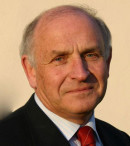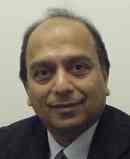Dr Andrew Molyneux
Founding member, UKNG chair 1990-1996

Dr Molyneux, who kindly shared his recent presentation at the 50th UKNG anniversary meeting with us, was a co-principal investigator of the landmark international Subarachnoid Aneurysm Trial (ISAT) and has been at the forefront of the development of minimally invasive endovascular treatment of brain aneurysms and arteriovenous malformations for 30 years. He is now a senior clinical research fellow at the Nuffield department of surgery at the University of Oxford, UK, and is an hononary consultant neuroradiologist at the Oxford Radcliffe Hospitals NHS trust and the North Bristol NHS trust.
Dr Anil Gholkar
Former UKNG Chair

Dr Gholkar is trained in Manchester and was appointed as Consultant Neuroradiologist in Newcastle in 1989. He has been the President of the British Society of Neuroradiologists, Chairman of Uk Neurointerventional group and RCR regional adviser.
The first meeting of UK Interventional Neuroradiologists was organised by Andy Molyneux at the Randolph Hotel in Oxford in March 1989, where the endovascular treatment of cerebral arterio-venous malformations (AVMs) and aneurysms was discussed. This meeting was a great success and led to the formation of the UK Neurointerventional Group (UKNG). The Group meets twice a year and is hosted by different Consultant Neuroradiologists at centres throughout the UK.
The presentations at the initial meetings were predominantly case based discussions. AVMs formed large part of our work and Cyanoacrylate (Blue glue) was the most available and discussed embolic agent. Guglielmi Detachable Coil (GDC) was first used in aneurysm treatment in Oxford in 1992 and was an exciting new development. Discussion of aneurysm treatment then started dominating our meetings. From the mid 1990’s there was an explosion in the development of device technology for aneurysm treatment as the industry realised the potential of this treatment. UKNG was at forefront of interventional practice through out this period.
The main aim of UKNG was to promote safe and effective interventional neuroradiology (INR) practice. The group provided much peer support and no one was afraid of presenting their complications. When complications were presented, there was a frank discussion while maintaining respect for the presenting members. As techniques developed and experience was gained, more outcome-based studies were presented.
The group strongly supports evidence-based practice and the success of the International Subarachnoid Aneurysm Trial (ISAT) was helped by the support it received from UKNG. Members have since gone on to design and conduct several other successful randomised trials and have become international experts in evidence based practice.
The group is often consulted by the BSNR and the RCR to give advice on INR related issues.
From the very beginning, we worked together with our colleagues from the industry. They supported us in various ways, by contributing to education and involving us in development of new products. For a very long time, the new products were used and assessed by the UKNG members before they became available elsewhere.
Over the years, Neuroradiologists at the forefront of INR practice from Europe and North America have been invited to speak at meetings. These guests enrich the meetings and several are honorary members of the group.
The social aspects of the meeting are very important; it provides opportunity for informal discussion while sampling good food and wine. We enjoy each other’s company and many good friendships have developed.
Without any doubt, UKNG has been instrumental in the success of INR practice in the UK. I hope that the current and particularly the younger members become actively involved in the group and adapt it to their needs for the future.
Learn more about the History of Interventional Neuroradiology